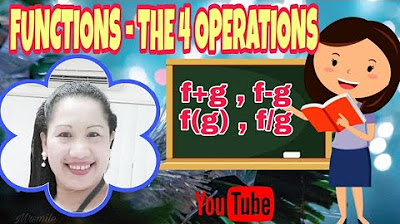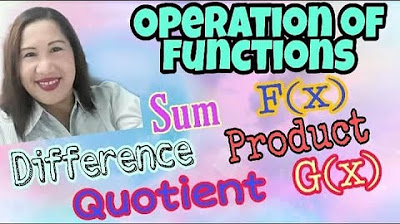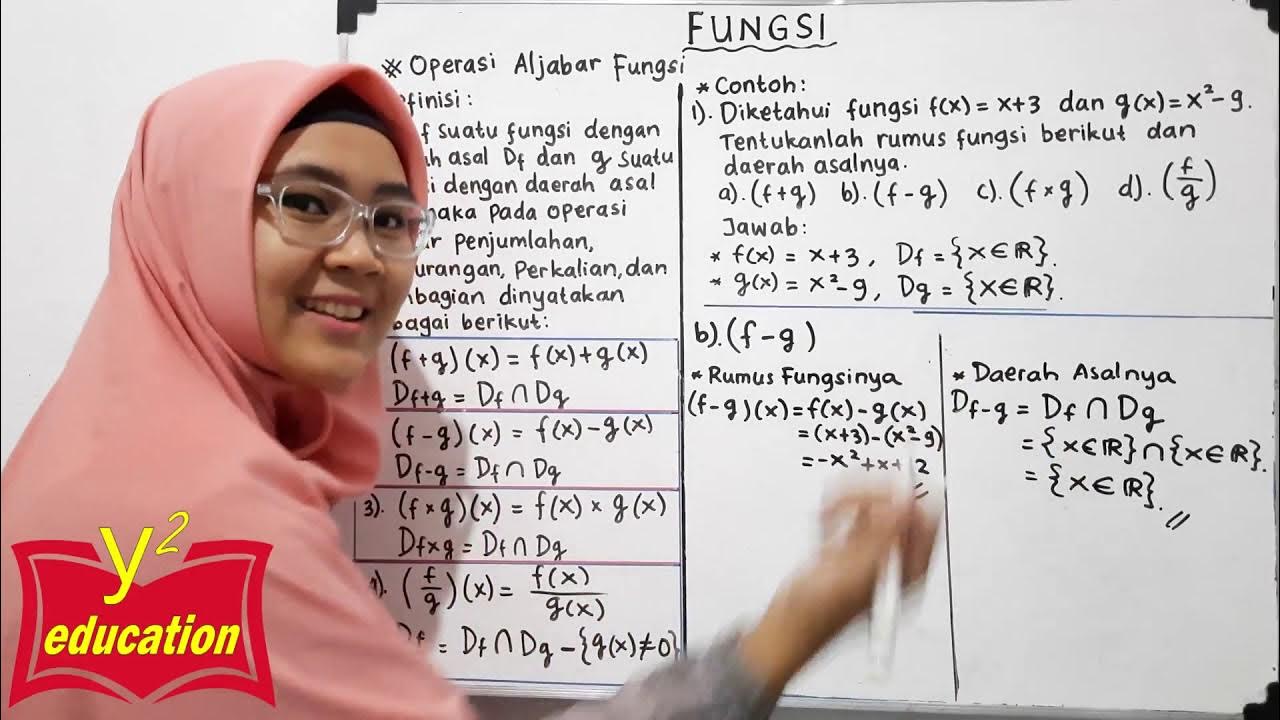Operations on Functions
Summary
TLDRThis video script introduces the fundamental operations of functions, including addition, subtraction, multiplication, and division, with the stipulation that division by zero is undefined. It demonstrates these operations step by step using specific functions, such as 'v(x) - p(x)', 'f(x) * p(x)', 'v(x) / g(x)', and 'f(x) + g(x)'. The script also includes examples of factoring and simplifying expressions, concluding with evaluating functions at a specific point, x = 3, to yield numerical results.
Takeaways
- ✏️ The objective is to perform fundamental operations with functions.
- ➕ The sum of two functions, f(x) and g(x), is given by f(x) + g(x).
- ➖ The difference between two functions is given by f(x) - g(x).
- ✖️ The product of two functions is f(x) multiplied by g(x).
- ➗ The quotient of two functions is f(x) divided by g(x), with the condition that g(x) is not equal to zero.
- 🔍 For subtraction, substitute the given functions and combine like terms.
- 🧮 For multiplication, use the distributive property to expand and simplify the expression.
- 🔄 For division, factor the numerator and denominator, then simplify by canceling common factors.
- 🔢 When adding functions, combine like terms after substituting the given values.
- ✍️ For specific values, substitute the given value of x into the functions and simplify.
Q & A
What are the fundamental operations that can be performed on functions f and g?
-The fundamental operations on functions f and g include the sum (f + g), difference (f - g), product (f * g), and quotient (f / g), provided that g(x) is not equal to zero to avoid division by zero.
What is the definition of the sum of two functions, f and g?
-The sum of functions f and g, denoted as f + g, is defined as f(x) + g(x) for all x in the domain of both f and g.
How is the difference between two functions, f and g, represented?
-The difference between functions f and g is represented as f - g, which is equal to f(x) - g(x) for all x in the domain of both f and g.
What is the definition of the product of two functions, f and g?
-The product of functions f and g is defined as f * g, which equals f(x) * g(x) for all x in the domain of both functions.
What is the definition of the quotient of two functions, f and g, and what condition must be met?
-The quotient of functions f and g is defined as f / g, which equals f(x) / g(x) for all x in the domain of both functions, provided that g(x) is not zero to avoid an undefined function.
In the given transcript, what is the expression for v(x) - p(x)?
-The expression for v(x) - p(x) is x^2 - 4x - 5 - (2x - 7), which simplifies to x^2 - 6x + 2 after combining like terms.
How is the product of f(x) and p(x) calculated in the transcript?
-The product f(x) * p(x) is calculated by multiplying (x + 3) with (2x - 7), resulting in 2x^2 - 7x + 6x - 21, which simplifies to 2x^2 - x - 21.
What is the quotient of v(x) divided by g(x) in the transcript, and how is it simplified?
-The quotient v(x) / g(x) simplifies to (x^2 - 4x - 5) / (x^2 - 25), which factors and simplifies to (x - 5)(x + 1) / (x - 5)(x + 5), and further simplifies to (x + 1) / (x + 5) after canceling out the common factor (x - 5).
What is the expression for f(x) + g(x) in the transcript, and how is it simplified?
-The expression for f(x) + g(x) is (x + 3) + (x^2 - 25), which simplifies to x^2 + x - 22 after combining like terms.
How is the value of f(x) + g(x) evaluated when x is substituted with 3 in the transcript?
-When x is substituted with 3, the value of f(x) + g(x) becomes 3^2 + 3 - 22, which simplifies to 9 + 3 - 22, resulting in -10.
In the transcript, what is the process for evaluating f(3) + g(3), and what is the result?
-The process involves substituting 3 for x in both f(x) and g(x), resulting in (3 + 3) + (3^2 - 25), which simplifies to 6 + 9 - 25, and the final result is -10.
Outlines

This section is available to paid users only. Please upgrade to access this part.
Upgrade NowMindmap

This section is available to paid users only. Please upgrade to access this part.
Upgrade NowKeywords

This section is available to paid users only. Please upgrade to access this part.
Upgrade NowHighlights

This section is available to paid users only. Please upgrade to access this part.
Upgrade NowTranscripts

This section is available to paid users only. Please upgrade to access this part.
Upgrade NowBrowse More Related Video
5.0 / 5 (0 votes)





